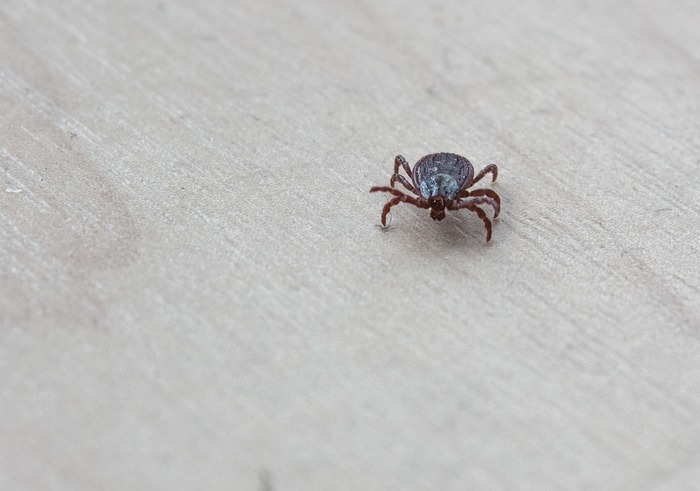
How to Get Rid of Mites on Dogs: A Vet’s Guide to Dog Mite Infestations
Fleas and worms are often the first things we think of when it comes to parasites in dogs. However, they aren’t the only critters who can cause trouble for your pet. In this article we’ll guide you on dog mites, signs of mites, how to keep your dog protected, and mite treatment.
Mites cause a range of problems in dogs, and some species of mites can also be transmitted to other pets and our pet parents! So, let’s find out everything you need to know about mites on dogs.
- Dog mites can cause skin problems and can be passed to other pets and humans.
- There are various types of mites, each requiring specific treatment plans.
- Intense itching and skin irritation are common signs of a dog mite infestation.
- A vet can diagnose mites using a skin scraping and provide effective treatments.
- Preventing mites involves cleanliness and regular pet care routines.
The information provided herein is for informational purposes only. Please refer to our disclaimer for more details..
- What is a dog mite?
- Are there different types of mites?
- Ear mite
- Sarcoptic mange
- Cheyletiellosis mite
- Demodex canis mites
- Symptoms of mites
- Do mites on dogs mean a trip to the vet?
- Treatment for a dog with mites
- How to prevent mites and protect your dog
- Mites in your dog – a summary
- Frequently Asked Questions
- Conclusion
What is a dog mite?
Image credits: Pixabay
Dog mites are tiny creatures that can live in a few places on your dog’s body, such as their ear canal, skin, and in their fur. Some species even burrow into your dog’s skin.
Depending on the species, they can be passed from one dog to another or they can be transmitted through the environment.
This means, that if your dog has contact with another dog who is infested, you have good reason to suspect that your dog is also infested.
Mites are very small and can be hard to see, depending on the species, and your dog’s coat. However, don’t worry, there are a few things to know about dog mites, to help you understand the symptoms of mite infestations and when to act.
Are there different types of mites?
There are several species of mites, which have their own preferred place to live on your dog, different manifestations, and specificities when it comes to treatment and diagnosis.
We’ll go through them in detail now and have included a summary table at the end of the article.
Ear mite
Otodectes cynotis mites can live in your dog’s ear and are especially irritating. This means that your dog is likely to itch, scratch, or shake their ear to try and relieve itself.
It’s good to know that this species can also infect cats, so if your vet diagnoses your dog with ear mites, it’s best to ask them about getting some treatment for your cat too if needed.
Sarcoptic mange
Sarcoptic mange is also known as scabies and these mites cause sarcoptic mange. The females of the species that cause it (Sarcoptes scabiei), lay eggs in the tunnels they make in a dog’s skin.
The poop from the mites is what is thought to cause the strong urge to itch that is often associated with these kinds of mites. Such intense itching can lead to irritation of the skin and secondary bacterial or fungal infections. However, it doesn’t always show symptoms.
It’s good to know that these mites can cause pet parents and other animals in the household to become infected.
It must be diagnosed and treated by a veterinarian, who will ask you lots of questions about your pet and then perform a clinical examination.
They may also perform a skin scrape to help confirm the presence of these mite species based on their appearance under the microscope.
The treatment for these mites includes special shampoo and medication. It’s important to give the medication to all the animals in the household.
Cheyletiellosis mite
These mites are sometimes called ‘walking dandruff’ for two reasons:
- They often cause your dog’s skin to become flakey.
- They are white and look like tiny moving white dots.
Aside from this, chyletiella yasguri mites cause your dog to itch. It’s also good to know that cheyletiella yasguri mites can also infect humans, although it’s not very serious and pretty easily treated.
Demodex canis mites
Demodex canis mites mites live in your dog’s hair and can be found under normal conditions. However, when their body is in balance, these mites don’t usually cause a problem.
In young puppies or those with a weaker immune system, the number of mites can increase to a harmful level and cause symptoms such as hair loss.
This type of mite doesn’t usually spread between dogs, the main factor which determines if it causes your dog problems, is the strength of their immune system.
Symptoms of mites
Image credits: Pixabay
The localization of dog mite symptoms can vary slightly depending on the species of mite but usually cause similar symptoms such as itching and problems with skin or hair. The severity of the symptoms can vary depending on the number of mites and your dog’s specific reaction to them.
Do mites on dogs mean a trip to the vet?
If you suspect your dog may have mites, it’s best to take them to your veterinarian to get a proper diagnosis. Many conditions in dogs can look like mites, so it’s best to rule out those conditions before starting treatment.
Don’t worry, the diagnosis of mites in dogs is pretty straightforward and doesn’t take much time (or money).
The process is likely to be as follows. Your veterinarian will take a brief medical history from you. This will involve asking about all aspects of your pet’s care routine, such as their food, exercise, and whether you treat them for parasites.
Don’t be alarmed if they also ask you whether any other pets or people in the house are affected. Some species of mites can also be transmitted to humans. Don’t worry, they are usually easily treatable.
After your vet has asked you for the above information, they will perform a clinical examination of your pet and look extra closely at any affected areas.
They may also take something called a skin scraping. This involves using a blade to take away some cells from the surface of your dog’s skin (if they suspect scabies). They may also take a swab from inside your dog’s ear (if they suspect ear mites) or some of their hair and look at it under the microscope.
Skin scraping is nothing to worry about for pet parents. It’s an unpainful procedure for your dog, and they won’t require any sedation for this process.
A bonus of skin scraping is that the results are available as soon as the procedure. This is because your vet just needs to take a look under the microscope. They will look for their presence and what the mites look like.
Treatment for a dog with mites
Treatment for dogs with mites depends on the species of the critter involved and the severity of the symptoms. Some examples of treatment are:
- Medicated shampoos
- Dips
- Oral medications.
The best choice in treatment for mites depends on the type of mite, and your dog’s condition. It’s important to get a proper diagnosis and treatment plan from your veterinarian to effectively and safely get rid of mites in your dogs.
How to prevent mites and protect your dog
Since most mites are spread by close contact with other dogs, it’s pretty complicated to prevent them.
However, keeping your dog’s coat in good condition and their environment and bedding clean is a good way to help reduce the chances of them getting mites.
Mites in your dog – a summary
| Name | Main signs | Diagnosis | Treatment | Don’t forget | |
|---|---|---|---|---|---|
| s | |||||
| Sarcoptic mange | Itching | History, Clinical examination, Skin scraping | Bathing with a special shampoo | Can be passed on to humans and other pets | |
| s | |||||
| Ear mite | Itching, shaking, or scratching the ear | History, Clinical examination | Ear cleaning and medication | Cats can get it too | |
| s | |||||
| Cheyletiellosis mite | Flaky skin ‘walking dandruff’ | History, Clinical examination | Shampoos | ||
| s | |||||
| Demodex mite | Hair loss | History, Clinical examination | Shampoos, Medication |
Frequently Asked Questions
In this section, we’ll briefly answer the most common questions regarding the topic of dogs and mites.
How can I tell if my dog has mites?
If your dog is itching, scratching, or shaking their head they may have hair mites. However, these symptoms are not specific to mites and could be due to a range of other conditions. You won’t be able to see the mites themselves without a microscope.
How did my dog get mites?
Most often, dogs pick up mites from other dogs who are infected with mites. This could mean, catching becoming infected by their other four-legged friends in the park, grooming parlor, or in kennels.
What kills mites on dogs instantly?
There are a variety of special shampoos and dips available on prescription from your veterinarian which are effective in killing mites. It’s best to take your dog to a veterinarian for a proper diagnosis and treatment.
Never administer anything to your pet unless following advice from a veterinarian.
Can humans catch mites from dogs?
Some species of mite such as the sarcoptes scabei and Cheyletiella mite are transmissible from dogs to humans. If you think your dog may have mites, it’s important to take them to a veterinarian for proper diagnosis and treatment.
If you think that you may have caught mites from your pet, it’s best to book an appointment with your doctor for proper diagnosis and treatment.
Can dog mites infest your house?
If your veterinarian has confirmed that your dog is infected with mites, then it’s a good idea to thoroughly wash all bedding, blankets, and pillows they’ve come into contact with.
Cleaning and thoroughly vacuuming areas also helps to remove mites and prevent your pet from becoming re-infested.
Conclusion
We hope you’ve enjoyed reading this guide on dog mites and that you’ve got the information you need to decide what to do to help cure your dog.
558views
Share on Facebook




10
1